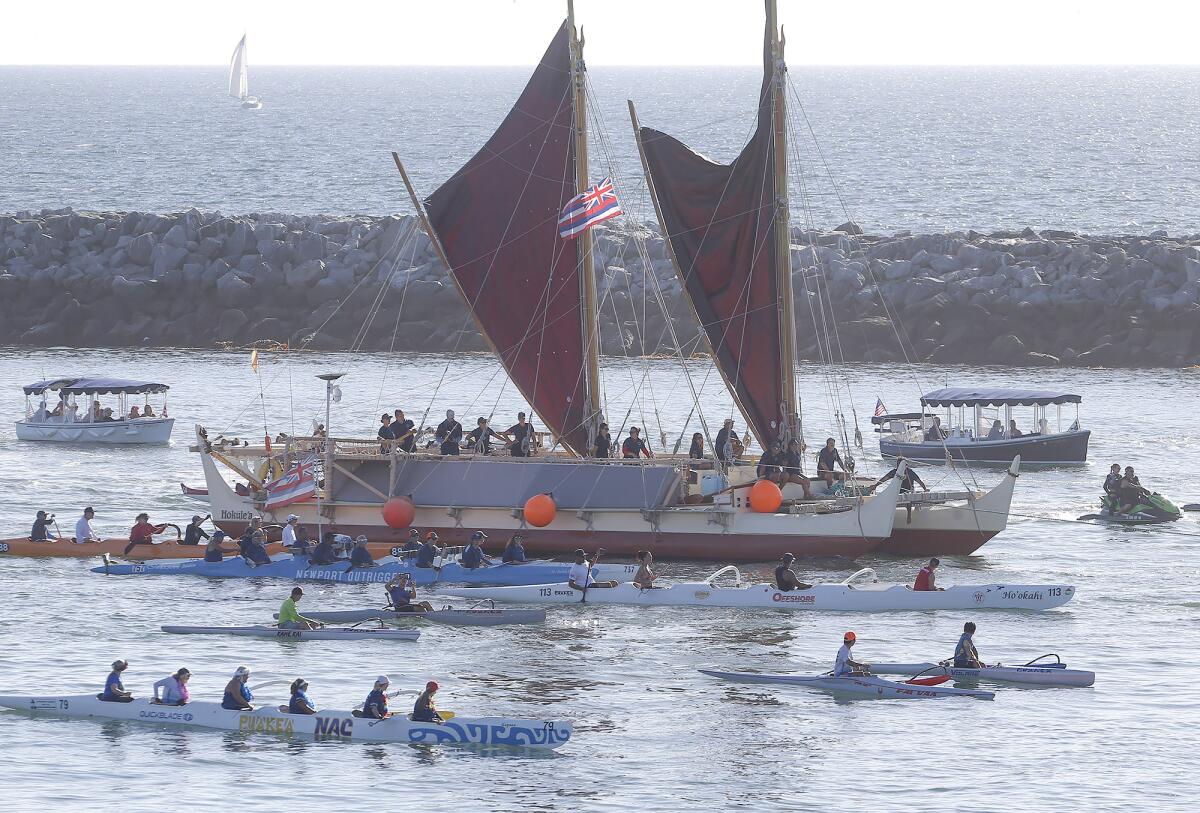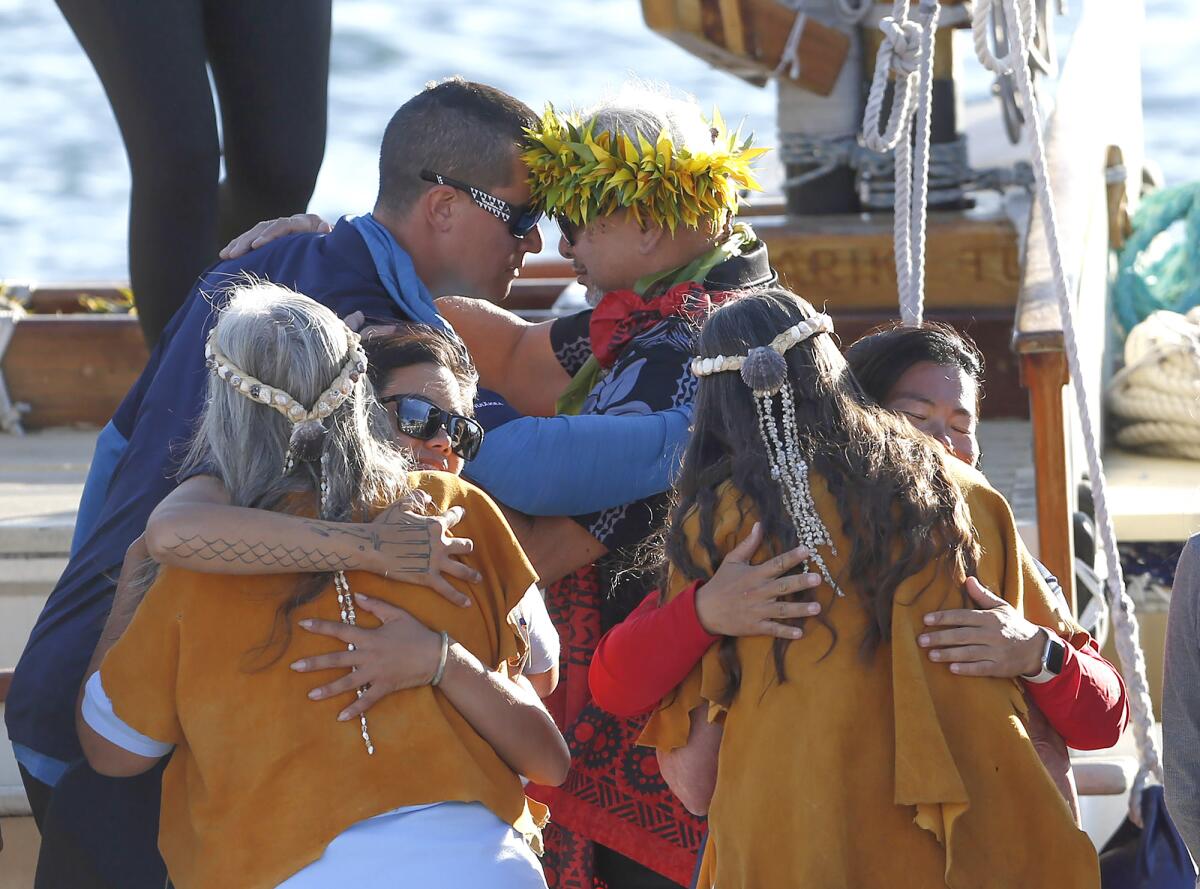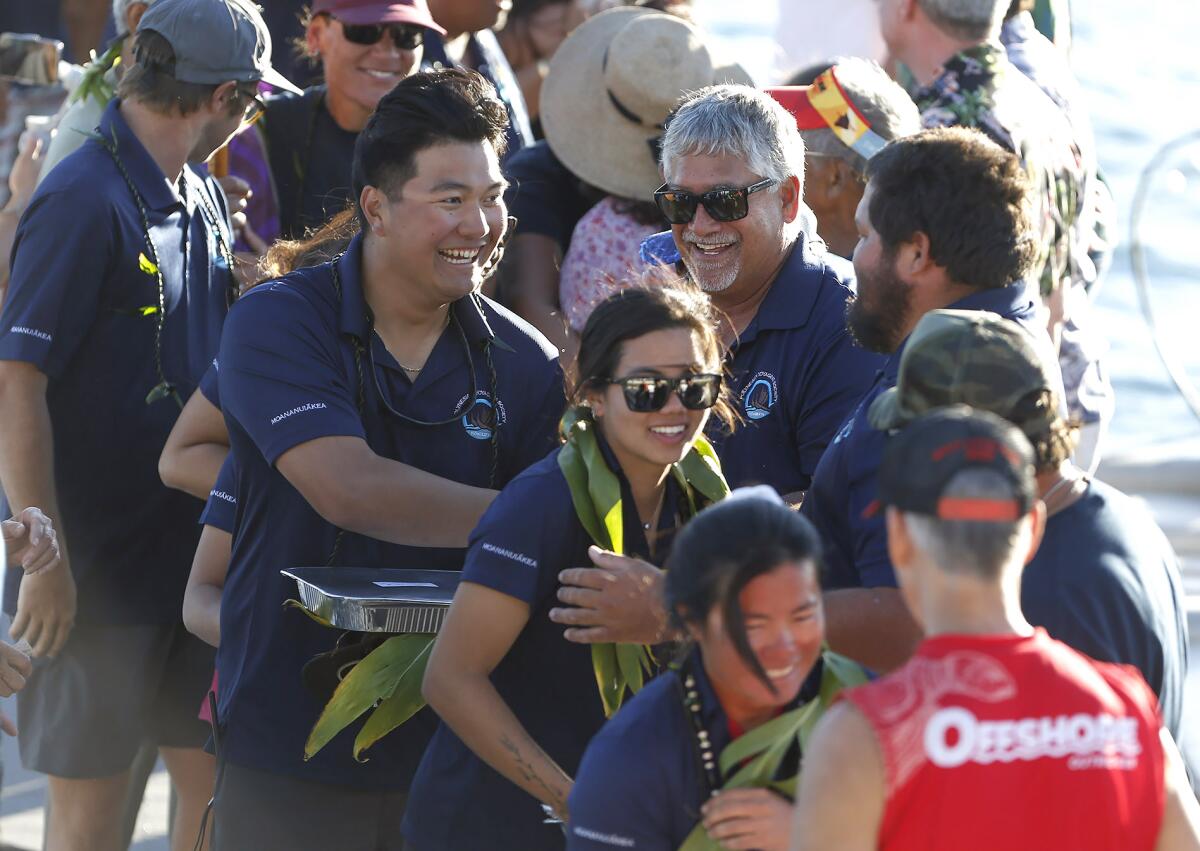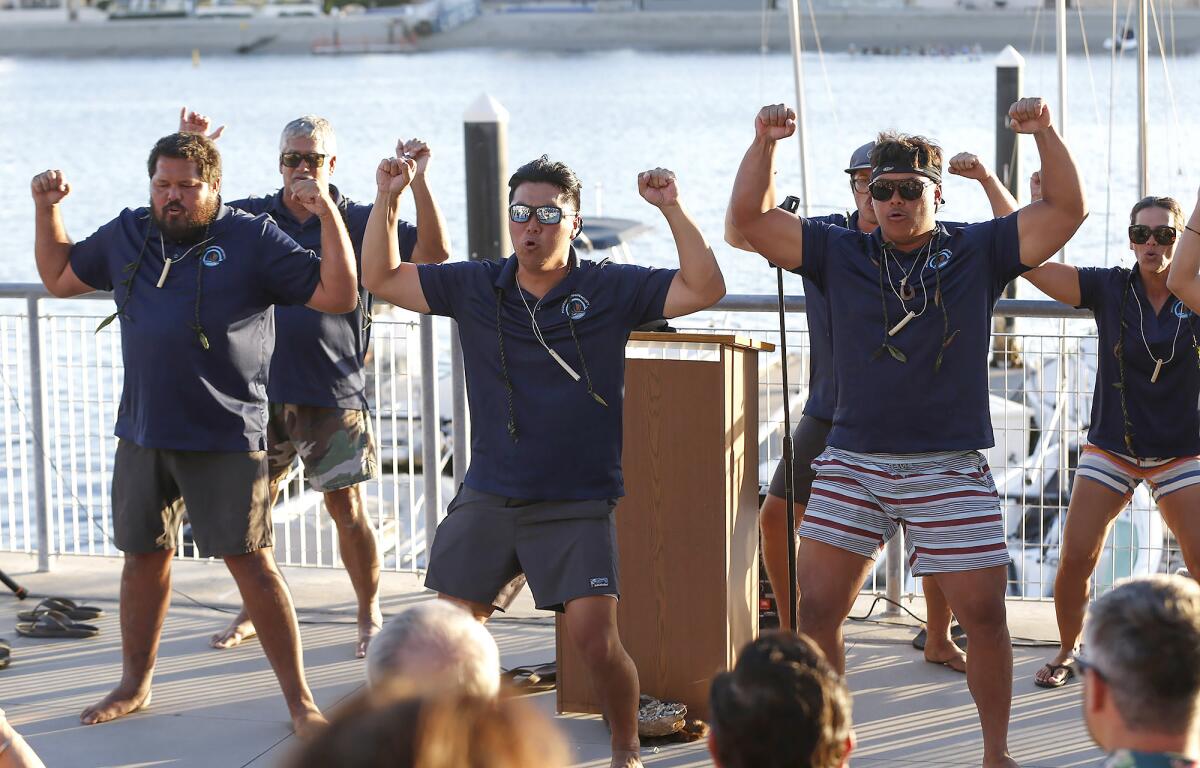Hokule‘a stops in Newport Beach on its trans-Pacific journey

- Share via
Even at a distance, the Hokule‘a and its crew could be heard before they were seen.
The sound of a conch horn announced the Hawaiian seafaring canoe’s arrival, as it was guided into the breakwater by canoes paddled by members of the Acjachemen Nation, whose ancestral lands span the distance south of Aliso Creek into what is now northern San Diego County.
As it pulled into the dock of the Newport Sea Base, onlookers leaned over the railing to catch a glimpse of the vessel and its crew.
Monday’s arrival marked the first time the Hokule‘a, a fiberglass and wood replica of the traditional canoes that once carried Polynesians across the sea, has been in Newport Beach’s waters. Community members facilitated the stop, according to officials at the Polynesian Voyaging Society, in coordination with the Newport Sea Base and the Newport Aquatics Center.
It was also its first visit to California’s coastline since 1995, with its first stop having been in Eureka earlier this fall.

“What a momentous day to be here with all of us who share the Pacific Ocean,” said Heidi Lucero, the chairwoman of Juaneño Band of Mission Indians Acjachemen Nation. “It’s the ocean that connects us, and we’re super happy to be here to share some of our traditional songs ... and we’re so happy to be here to welcome you and be a part of this special day.”
The crew of the Hokule‘a received greetings in the form of song and dance, as well as from speakers representing the Newport Sea Base, the Newport Aquatics Center and Orange Coast College.
The Hokule‘a, which will remain in Newport Beach through Saturday, was built in 1975 and took its maiden voyage to Tahiti in 1976. It was born of a desire to disprove theories proposed by Norwegian explorer and ethnographer Thor Heyerdahl, who suggested the first people of the Pacific Islands came from the east by accident, with Polynesians having “drifted” to them on the prevailing winds and currents.
The deep-sea canoe has ventured out on a number of widely reported trips since, including to New Zealand, American and Western Samoa, the Cook Islands and Easter Island. It is now on its perhaps most ambitious trip across the Pacific yet, called Moananuiakea, a voyage for the ocean and for the Earth.

The journey began in the coast of southeast Alaska in June and was originally expected to take four years to complete. The goal was to span an estimated 43,000 nautical miles, 36 countries and archipelagos, nearly 100 indigenous territories and over 300 ports.
But the vagaries of nature have intervened. Instead of continuing on its planned route southward to Central and South America, Hokule‘a will return to its native Hawaii after making a stop in San Diego.
“Our communities in Hawaii have been asking for us, for our people, to come home because of the recent tragedies with the wildfires,” Polynesian Voyaging Society chief executive officer and navigator Nainoa Thompson said in an interview Tuesday. “But, also, looking at the progression of El Niño — we are living in a different world. We need to learn how to adapt to the changes that are upon us.”
Early projections by the National Oceanic and Atmospheric Administration indicate warm and wetter than typical winter for California and much of the rest of the country. The weather pattern El Niño is expected to remain through spring, and is a major driver of temperature and precipitation across the globe.
“We needed to make a decision, and the primary driver is safety. Our challenge is we’re in a different world and we don’t have the long term data to be able to forecast what 2023 or 2024 is going to look like,” Thompson said. “We’re going home because the community asked, but the question is going to be what are we going to do [going forward]?”

Thompson said the plan is to catch the rest of the Americas at the tail-end of the journey, as it would be difficult to travel to them from Hawaii, but the question of when that will happen remains up in the air. He said it may be possible the Hokule‘a will remain in Hawaii throughout 2024 because of the weather patterns, but that decision will likely be made in mid-December.
About 10 to 12 people man the Hokule‘a at any given time, though the crew size largely depends on the physical demands of each trip.
Bruce Blankenfeld, who is also a navigator and director of training for the Polynesian Voyaging Society, said the history of voyaging, and the continuation of it, is as much a part of the Hawaiian culture as its language, hula, handicrafts and relationship with the ocean. He has been a longtime member of the Hokule‘a crew.
For Thompson, the Hokule‘a’s continued voyages are a direct challenge to all attempts — “the same chronic story of our native peoples” — to crush native Hawaiians and extinguish their culture.

Thompson said he was in school when teaching, learning and speaking in Hawaiian was banned. He said he graduated from high school without knowing anything about his people, but directly credits the Hokule‘a’s construction and maiden voyage as having brought about what he calls a “Hawaiian renaissance.”
“At the time of the Hokule‘a was launched, the estimate was that there were less than 100 native speakers, and they were all aging. Today, because of the language immersion schools [which returned in the late 1970s], there’s about 22,500. This is a story about restoration. This is a story about renewal. This is a story about reclaiming and a story about the emergence of culture, language and genealogy and ancestry as the basis of health for native people,” Thompson said. “Our work is far from done, but what we’re doing right now is close the first 50 years and open up the next 100.”
The Polynesian Voyaging Society offered public tours of the Hokule‘a on Wednesday, and the crew will hold a presentation at the Orange Coast College Boathouse on Thursday from 6 to 8 p.m. It will then move down to the Ocean Institute in Dana Point before finishing its run of California’s coast in San Diego, where it will dock from Nov. 8 to 14.
For more information, visit hokulea.com.

All the latest on Orange County from Orange County.
Get our free TimesOC newsletter.
You may occasionally receive promotional content from the Daily Pilot.




